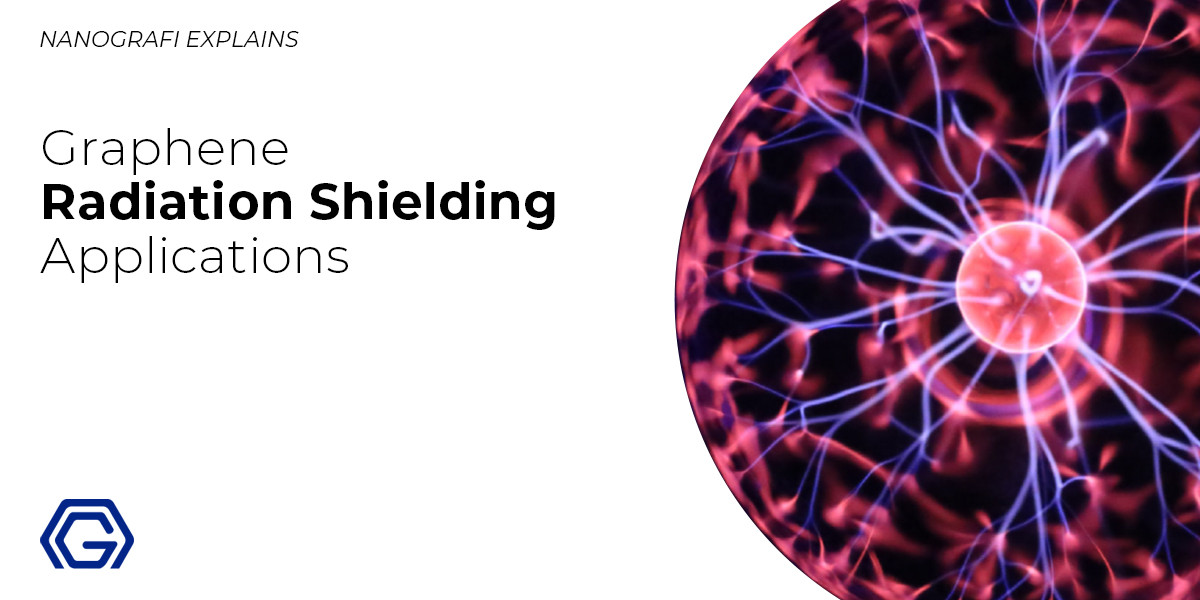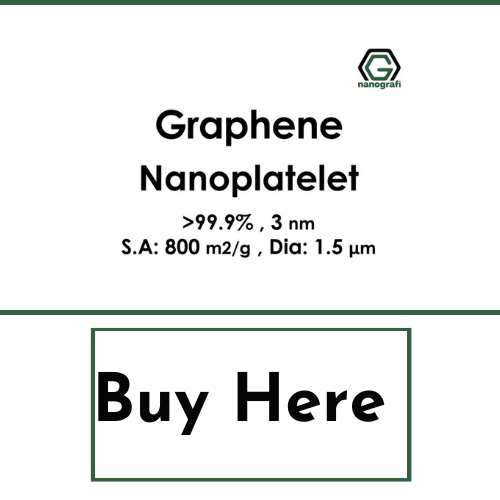Graphene Radiation Shielding Applications
Graphene based materials including mono and multi-layered graphene, graphene/polymer composites, and functionalized graphene oxide are utilized in electromagnetic interference shielding applications such as radio wave, x-ray, microwave, and UV shielding.
Radiation is a great part of our lives because of the natural radiation surrounding us and especially because of the electronic devices we use on a daily basis.
Introduction
Natural radiation including radiation from our bodies and background radiation is inescapable and harmless. However, the radiation we are exposed to because of the electronic devices increases constantly and considered to be harmful. Radiation, which is also referred as electromagnetic waves, is defined as energy that comes from a source and travels through space at the speed of light. This energy has a wave-like behaviour, creates an electric and magnetic field. Electromagnetic spectrum is used to describe the entire range of radiation that exists. Electromagnetic radiation is classified into categories based on the frequency of the waves. These categories can be listed from high frequency to low frequency as gamma rays, X-rays, UV, visible light, infrared, microwave and radio waves. Radiation types are also categorized as ionizing and non-ionizing radiation. Ionizing radiation causes the formation of charged particles in the matter due to their high energy. X-rays and gamma rays belong to the ionizing radiation category. The major radiation types caused by technological devices are x-rays and radio waves. Medical imaging devices are the source of x-ray radiation while the electronic devices such as TVs are the source of radio waves.
Radiation Shielding
The rapid technological developments and resulting electromagnetic pollution problem have led to the radiation shielding concerns due to the effects of radiation on the human health. Electromagnetic interference (EMI) shielding is an important concern essential to protect the human health, environment, and workspaces. EMI shielding works with reflection and absorption of electromagnetic radiation by a material which acts as a shield against the penetration of the radiation energy. Scientists have been trying to keep radiation levels minimum by using optimum materials. Even though it is possible to provide radiation shielding with a wide range of materials, some parameters such as effectiveness, cost, size, and mass must be taken into consideration. The most commonly used radiation shielding materials are concrete, tin, lead, and copper. However, scientists have been on the look for new radiation shielding materials to improve the performance. Conventional metal based EMI shielding materials are heavy, prone to corrosion, and brittle. Furthermore, these materials have a reflective radiation shielding mechanism. Hence, new materials such as polymer composites are suggested as an alternative. Graphene is another promising material for EMI shielding applications.
The Role of Graphene in Radiation Shielding
Carbon itself is not considered as a radiation shielding material due to its low atomic number (Z=6). However, the wonder material graphene can offer some considerable radiation absorbing properties. The high conductivity, saturation velocity, flexibility, excellent optical properties, and mechanical strength of graphene make it an excellent choice of material for high-performance EMI shielding. Graphene is utilized in various forms for EMI shielding applications including mono and multi-layered graphene structures, functionalized graphene, and composites with different materials. The most of the researches focus on the radio frequency shielding and x-ray shielding since these radiations are at the centre of attention.
Radio Frequency Shielding
The new generation technological devices require much more sophisticated materials and technologies. As the density of electronic devices increases in our daily lives, the requirement for radio frequency shielding materials also increases. Graphene-based materials have the upper hand on the conventional shielding materials due to their flexibility, light weight, high conductivity, resistance to corrosion, and processing advantages.
Mono-layered graphene which contains a hexagonal carbon network and obtained by chemical vapor deposition technique is proven to be an effective EMI shielding material. Mono-layered graphene has an average shielding effectiveness of 2.27 dB corresponding to ∼40% shielding of incident waves. This shielding effectiveness value is four times higher than that of gold film. However the high resistivity of graphene limits its application in EMI shielding. The multi-layered graphene structures are much more promising materials for EMI shielding applications. Thermally treated GO films are used to obtain a flexible multilayered graphene film. The EMI shielding effectiveness of multi-layered graphene is found to be 70 dB from 2.6 GHz to 40 GHz. The high conductivity of 1.13 × 106 S/m and low sheet resistance of 32.7 mΩ of multi-layered graphene film are great assets for the high shielding effect of multi-layered graphene.
If you are interested in the application areas of graphene nanoplatelets,
you can read our blog post here.
Graphene composites have gained a lot of attention in EMI shielding applications, in addition to mono and multi-layered graphene structures. Composites of graphene mostly include epoxy and polar polymers such as PMMA, PAN and poly(acrylic acid) (PAA). Additionally, the carbon nanotubes (CNTs) are often included in these composite structures. Conductive polymers have been suggested as the alternative material for EMI shielding applications. However, the these polymers show some disadvantages such as low stability during processing, high cost, low thermal stability and as consequence limited service temperature or globally poor mechanical performance. This is why the graphene/polymer composites are offered as a promising solution. The electromagnetic shielding effect and the durability of composites are considerably improved in comparison to conductive polymers. The inclusion of CNTs further improves the EMI shielding effectiveness of composites reaching as high as 98 dB. The graphene structure in these composites are often functionalized GO since it provides better connectivity with the polymeric material. Graphene/epoxy composite is also suggested for the EMI shielding applications however, the shielding effectiveness of these composites is relatively low.
X-Ray Shielding
X-ray radiation have a wide range of application areas including medical applications, radiation therapy and imaging, space technology, nuclear power plants, reactor design and agricultural applications. It is well-known that x-ray radiation is harmful to the human health and nature. Thus, the handling of x-ray radiation requires much attention and x-ray shielding precautions. Recently, lead-oxide decorated graphene/epoxy composites have attracted attention in x-ray shielding applications. Composites containing GO-Pb3O4 have high rate of shielding effectiveness against X-ray radiation. The use of this graphene based composite can lead to the development of f lightweight, non-toxic, highly effective X-ray radiation shields for various purposes.
Microwave Shielding
Another source of electromagnetic pollution is accepted as microwave radiation mostly caused by radars and microwave ovens. Conductive hybrid graphene films composed of mono-layered graphene on different substrates such as quartz glass are suggested for microwave shielding applications. The shielding effectiveness of such hybrid structures can go up to 29 dB. Another graphene based suggestion for microwave shielding is decorated graphene structures. MnO2 decorated graphene nano ribbons (GNRs) are reported to show good absorption dominated shielding effectiveness of approximately 57 dB blocking the 99.99% of the microwave radiation. Such graphene based materials are promising candidates for future applications.
Ultraviolet Shielding
The increasing awareness towards the detrimental effects of strong UV radiations arising from global warming concerns has encouraged the ultraviolet shielding studies. Especially fabrics that provide UV protection are gaining importance. Studies have shown that graphene nanoplates can be used as novel UV absorbers on the surface of cotton fabrics. The surface functionalization of cotton fabric with graphene nanoplates provides ten times stronger UV protection than the simple fabric. GO nanosheet/polymer composites are also suggested for enhanced UV protection of cotton fabric providing similar strength of UV protection as graphene nanoplates.
Conclusion
Electromagnetic radiation is an integral part of our daily lives. Electronic devices such as TVs, microwave ovens, medical imaging devices, and radars all depend on electromagnetic radiation and cause significant electromagnetic pollution which is harmful to human health and nature. Hence, the development of EMI shielding materials has gained importance with the development of technology. The conventional EMI shielding materials are metal based, bulky, and heavy. As with many other areas, the wonder material graphene is also utilized in EMI shielding applications. Graphene is used for radio wave, x-ray, microwave, and UV shielding. Several different forms of graphene used for EMI shielding purposes include mono and multi-layered graphene, graphene/polymer composites, and functionalized GO materials. Graphene based EMI shielding materials offer high shielding effectiveness, flexibility, light-weight systems, and stability.
To get more information, you can visit Blografi.
References
1.Hong, S. K., Kim, K. Y., Kim, T. Y., Kim, J. H., Park, S. W., Kim, J. H., & Cho, B. J. (2012). Electromagnetic interference shielding effectiveness of monolayer graphene. Nanotechnology, 23(45), 455704.
2.Fan, C., Wu, B., Song, R., Zhao, Y., Zhang, Y., & He, D. (2019). Electromagnetic shielding and multi-beam radiation with high conductivity multilayer graphene film. Carbon, 155, 506-513.
3.Liang, J., Wang, Y., Huang, Y., Ma, Y., Liu, Z., Cai, J., ... & Chen, Y. (2009). Electromagnetic interference shielding of graphene/epoxy composites. Carbon, 47(3), 922-925.
4.Abbasi, H., Antunes, M., & Velasco, J. I. (2019). Recent advances in carbon-based polymer nanocomposites for electromagnetic interference shielding. Progress in Materials Science, 103, 319-373.
5.Hashemi, S. A., Mousavi, S. M., Faghihi, R., Arjmand, M., Sina, S., & Amani, A. M. (2018). Lead oxide-decorated graphene oxide/epoxy composite towards X-Ray radiation shielding. Radiation Physics and Chemistry, 146, 77-85.
6.Tang, X., Tian, M., Qu, L., Zhu, S., Guo, X., Han, G., ... & Xu, X. (2015). Functionalization of cotton fabric with graphene oxide nanosheet and polyaniline for conductive and UV blocking properties. Synthetic Metals, 202, 82-88.
7.Qu, L., Tian, M., Hu, X., Wang, Y., Zhu, S., Guo, X., ... & Tang, X. (2014). Functionalization of cotton fabric at low graphene nanoplate content for ultrastrong ultraviolet blocking. Carbon, 80, 565-574.
Recent Posts
-
Advanced Materials for Unmanned Aerial Vehicle (UAV) Protection Against Laser
Consider a UAV on a critical mission, rendered inoperative by a sudden laser attack. With the increa …26th Jul 2024 -
Simulation and Modeling of Material Properties
Our world is composed of a dazzling array of materials, each with its own unique properties that dic …19th Jul 2024 -
Advanced Coatings for Superior Corrosion and Wear Resistance
Corrosion and wear pose significant challenges across various industries, leading to substantial eco …12th Jul 2024







